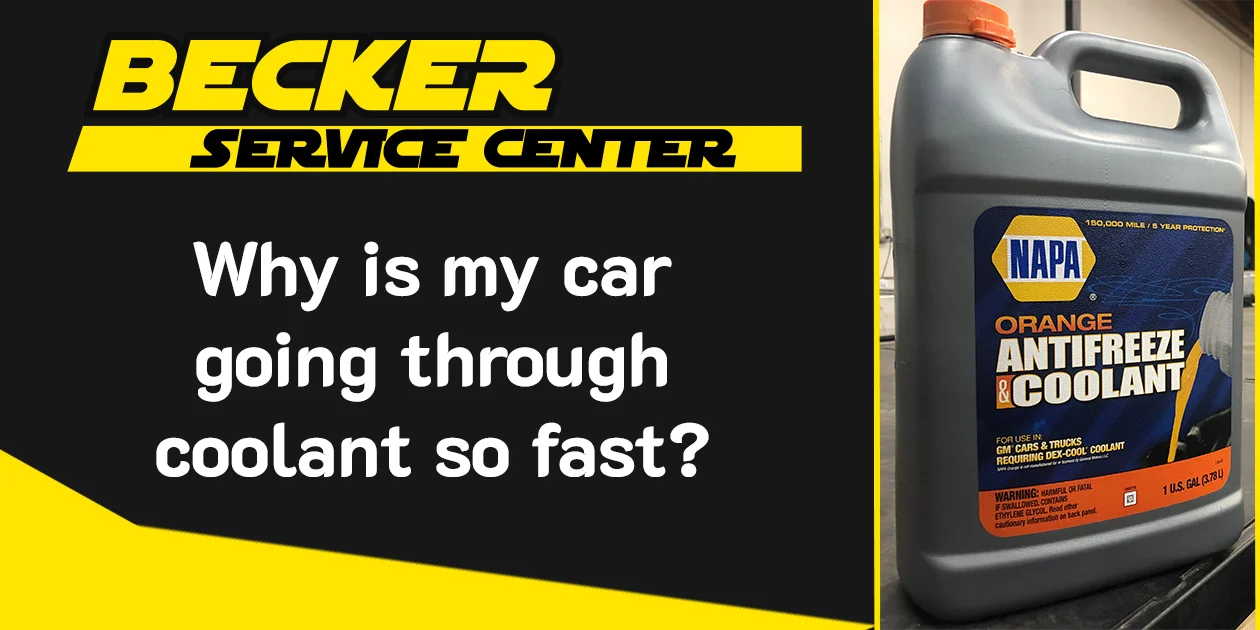Is your car using too much coolant? This can be a worrying sign.
High coolant use often points to an underlying issue. Coolant is crucial for your car’s health. It helps regulate the engine’s temperature. When your car uses too much, it can signal problems like leaks or engine issues. Understanding why this happens can save you time and money.
You don’t want to ignore it. Unchecked coolant loss can lead to bigger, more costly repairs. In this blog post, we’ll explore common reasons for excessive coolant use. You’ll learn what to watch for and when to seek help. Keep reading to protect your car and your wallet.

Credit: beckerservicecenter.com
Common Causes Of Coolant Loss
Experiencing frequent coolant loss can be frustrating and alarming. Understanding the reasons behind this issue is crucial. There are several common causes of coolant loss that every car owner should be aware of.
Leaking Radiator
A leaking radiator is one of the most common causes of coolant loss. Radiators can develop leaks due to age, wear, or damage from road debris. Signs of a leaking radiator include visible coolant puddles under your car and a low coolant level in the reservoir.
Here are some common symptoms of a leaking radiator:
- Coolant puddles under the car
- Overheating engine
- Low coolant light on the dashboard
If you suspect a radiator leak, it’s important to inspect the radiator and hoses for any visible signs of damage. Replacing or repairing a damaged radiator promptly can prevent further coolant loss.
Faulty Water Pump
A faulty water pump can also lead to coolant loss. The water pump is responsible for circulating coolant through the engine. If it fails, coolant may leak out, leading to a drop in coolant levels.
Symptoms of a faulty water pump include:
- Coolant leaks around the water pump
- Engine overheating
- Whining noise from the engine
To address a faulty water pump, a thorough inspection is necessary. Replacing a defective water pump can restore proper coolant circulation and prevent further loss.
Signs Of A Coolant Leak
Noticing your car using too much coolant can be alarming. Coolant leaks can lead to serious engine problems. Recognizing the signs early can save you from expensive repairs. Here are some common signs of a coolant leak.
Puddles Under The Car
If you see puddles under your car, it could indicate a coolant leak. Coolant is usually bright green, orange, or pink. These colors make it easy to spot. Check for puddles after your car has been parked for a while. Ensure you look under the engine area. If you find a puddle, it is time to inspect the coolant system.
Low Coolant Light
Your car’s dashboard has many warning lights. One of them is the low coolant light. This light comes on if the coolant level is too low. It is important to act fast when you see this light. Continuing to drive with low coolant can damage your engine. Always check the coolant level when this light appears.
Diagnosing Coolant System Issues
Diagnosing coolant system issues is essential if your car uses too much coolant. Understanding potential problems helps you maintain your vehicle’s health. This section will guide you through common diagnostics methods.
Pressure Test
A pressure test helps identify leaks in the cooling system. This test involves attaching a pressure tester to the radiator. The tester pressurizes the system, simulating the pressure that builds up during driving. If the pressure drops, there is likely a leak somewhere. You will need to inspect all parts of the cooling system. Look for any escaping coolant.
Visual Inspection
Performing a visual inspection can reveal obvious problems. First, check the radiator and hoses. Look for any cracks or leaks. Examine the water pump and thermostat housing. These parts can also leak. Look at the coolant reservoir. Ensure it is not cracked or damaged. Inspect the radiator cap. It should fit tightly and be free of damage. Check the engine compartment for coolant stains. These stains indicate a leak.
Internal Engine Problems
Internal engine problems can cause your car to use too much coolant. These issues are serious and need immediate attention. They can lead to severe damage if ignored. Two common internal engine problems are a blown head gasket and a cracked engine block. Let’s explore these issues and their signs.
Blown Head Gasket
A blown head gasket can cause your car to lose coolant. The head gasket seals the engine block and cylinder head. If it fails, coolant can leak into the engine. This leak can mix with the oil or burn off in the combustion chamber. Signs of a blown head gasket include white smoke from the exhaust, milky oil, and overheating. If you notice these signs, seek professional help immediately.
Cracked Engine Block
A cracked engine block is a serious issue that can cause coolant loss. The engine block houses the cylinders and other key parts. A crack in the block can cause coolant to leak out. This can lead to engine overheating and severe damage. Signs of a cracked engine block include visible coolant leaks, overheating, and a rough-running engine. Repairing a cracked engine block can be costly, so it’s important to act quickly.
External Coolant Leak Sources
Is your car using too much coolant? External coolant leak sources might be the culprit. These leaks can cause your coolant to drop quickly. Identifying these sources helps prevent engine damage. Let’s explore some common external leak sources.
Radiator Hose Damage
Radiator hoses carry coolant between the engine and radiator. Over time, these hoses can wear out. Cracks or splits in the hoses lead to leaks. Check for visible damage or wet spots around the hoses. Replacing old or damaged hoses can stop leaks.
Heater Core Leaks
The heater core is part of your car’s heating system. It uses coolant to heat the air inside the car. If the heater core leaks, you may notice a sweet smell inside the car. A foggy windshield can also indicate a leak. Check the passenger side floor for wetness. Fixing a heater core leak often requires a mechanic’s help.

Credit: www.reddit.com
Coolant Maintenance Tips
Maintaining your car’s cooling system is essential. It prevents overheating and ensures your engine runs smoothly. Let’s dive into some key coolant maintenance tips.
Regular System Checks
Check your coolant level often. It’s best to do this once a month. A low coolant level could mean a leak. Also, inspect the radiator and hoses. Look for any signs of wear or damage. Address issues quickly to avoid bigger problems later.
Using The Right Coolant
Not all coolants are the same. Check your car manual to find the right type. Using the wrong coolant can damage your engine. Mixing different coolants is also a bad idea. Stick to one type for best results. This keeps your cooling system healthy and efficient.
Temporary Fixes For Coolant Leaks
Experiencing frequent coolant loss may signal a leak. Quick fixes can prevent further damage and keep your car running. Regular checks and minor repairs can help manage the issue temporarily.
Is your car consuming too much coolant? You might have a leak. Fixing a coolant leak permanently can be costly and time-consuming. Sometimes, a temporary fix can help. These quick solutions can keep your car running. They are not permanent but can save you from immediate trouble.Radiator Sealants
Radiator sealants are a quick fix. You can buy them from any auto store. They work by sealing small leaks in your radiator. Pour the sealant into the radiator. It will circulate and seal the leaks. This method is simple and effective. Remember, radiator sealants are not a permanent solution. They can clog up your system over time. Use them only as a temporary fix. Always follow the instructions on the product.Coolant Leak Additives
Coolant leak additives are another option. These products work like radiator sealants. They seal leaks in the cooling system. Pour the additive into the coolant reservoir. It will mix with the coolant and find the leaks. Coolant leak additives can stop leaks quickly. They are easy to use and readily available. But like sealants, they are not a long-term solution. They can also cause build-up in the system. Always read the instructions before use. “`
Credit: f30.bimmerpost.com
When To Seek Professional Help
Experiencing unexpected coolant loss in your car? It’s crucial to know when to seek professional help. Some issues require expert diagnosis and repair to prevent further damage to your vehicle.
Persistent Coolant Loss
If you notice your car is consistently low on coolant, it may have a leak. Coolant leaks can occur in various parts of the cooling system, such as the radiator, hoses, or water pump. Regularly topping off the coolant without identifying the source can lead to severe engine damage.
Signs of a coolant leak include:
- Puddles of coolant under your car
- Sweet smell from the engine bay
- Visible coolant on engine components
If you observe any of these signs, it’s time to consult a mechanic. Persistent coolant loss can lead to overheating and engine failure if not addressed promptly.
Overheating Issues
Overheating is a serious issue that should not be ignored. If your car overheats frequently, it may indicate a problem with the cooling system. Overheating can damage the engine and lead to costly repairs.
Common causes of overheating include:
- Faulty thermostat
- Clogged radiator
- Broken water pump
If your temperature gauge rises into the red zone, pull over immediately. Allow the engine to cool before checking the coolant level. If the problem persists, seek professional help to diagnose and repair the issue.
Frequently Asked Questions
Why Is My Car Using So Much Coolant?
Your car might have a coolant leak, a broken radiator, or a faulty head gasket.
How Can I Detect A Coolant Leak?
Check for puddles under your car. Look for a sweet smell or white smoke from the exhaust.
Can A Bad Thermostat Cause Coolant Loss?
Yes. A bad thermostat can cause overheating, leading to excess coolant usage.
Is It Safe To Drive With Low Coolant?
No. Driving with low coolant can cause engine overheating and serious damage.
What Are Signs Of A Blown Head Gasket?
Look for white exhaust smoke, coolant in oil, or engine overheating. These are key signs.
Conclusion
Regular coolant checks can prevent serious engine problems. Inspect hoses for leaks. Look for signs of a failing radiator. Keep an eye on the water pump. Address issues promptly to avoid costly repairs. Monitor your coolant levels weekly. A well-maintained cooling system ensures your car runs smoothly.
Don’t ignore warning signs. Seek professional help if needed. Your car’s performance depends on proper care. Stay vigilant, and enjoy a reliable ride.

















